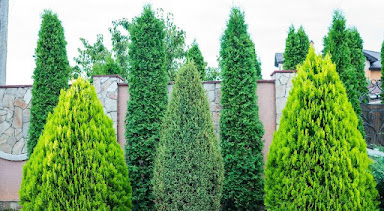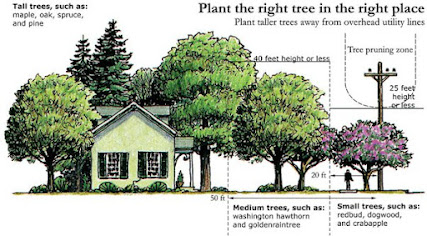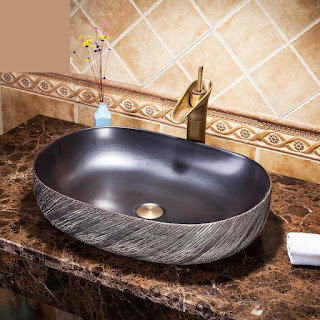How to Select Tree for Your Garden
Choosing the right trees for your garden can feel overwhelming and we often leave landscaping in the ‘too hard basket’.
1. Start with why
What would you like your tree to do for you? This question is important because not all trees offer the same features. You might like privacy, shade, greenery around your entertainment area, something for the kids to climb, or colours and textures to complement your home design.
Once you’ve determined the ‘why’ you can start a process of elimination — starting with size.
2. Size matters
Many tree removals in urban areas are a result of the wrong tree in the wrong place. Look at the size of your yard and any objects nearby including your house, power lines, fences and driveways. Your little elm might look cute now, but in 15 years it could be leaning against your carport.
A quick Google will help you with tree measurements but here’s a guide to some popular tree species and their typical heights:
Small (<8m) Medium (to 8m) Large (to 15m)
Japanese maple (D) Ornamental pear (D, F) Chinese elm (D)
Bottle brush (E, N, F) Chinese pistachio (D) Liquid amber (D)
Silk tree (D, F) Desert ash (D) Eucalyptus mannifera (E, N, F)
Crepe myrtle (D, F) Irish Strawberry (E) Red oak (D)
Dwarf cypress (E) Magnolia* (E, F) Red flowering gum (E, N, F)
D = deciduous E= evergreen N = native F = flowering *varied heights
Now you’ve looked at size, you can think about leaves!
3. Evergreen or deciduous
If you’d like your tree to give privacy or year-round shade, you’ll want an evergreen. As the name suggests, they won’t shed leaves in autumn. Evergreens are also a good idea if you don’t like raking up leaves. Bottle brush and Magnolias are great options for privacy. Irish strawberry and our native Eucalypts are also wonderful evergreens.
If you want shade in summer but sun in winter, you’ll want a deciduous tree. These trees put on a spectacular colour show in autumn just before dropping their leaves and letting the sun warm your home. Ornamental pears, Japanese maples and Red oaks are beautiful deciduous trees.
4. Hottest of the bunch
Much like how we dress or who we date, the attractiveness of a tree is subjective, so I can only share my personal opinion here.
Our natives provide gorgeous textures and colours year-round. They complement modern-Australian architecture and are low maintenance. Eucalytpus mannifera have smooth white trunks and flower in late summer / early autumn. Wattles are early spring bloomers adding bursts of yellow to the yard while Bottle brushes and Banksias give pops of red and orange. All of these attract native birds and bees adding even more beauty to your mini forest.
Then there are the show offs! Maples take our breath away in autumn with their red, orange and yellow show. Ornamental pears also have a colour show plus they flower in spring. Magnolias have glossy, dark green leaves and feature exotic looking pink or white flowers. And if hot pink or purple flowers in summer are your thing consider a Crepe myrtle.
Plant selection is an organized process that examines the following factors: function, aesthetics, site adaptability and management. While personal preference and looking good certainly justify a selection, the value of a plant may be a lot more than just aesthetic appeal.
Function guides the selection of a plant type- a tree, shrub, or perennial for a specific space. The aesthetic qualities of plants are as diverse as the species there are to choose from. Typical plant characteristics that contribute to its aesthetic include the overall habit or shape of the plant, its structure, determined by its foliage, canopy and trunk in the case of a tree or a shrub, and colour and texture from flowers, fruits, leaves and the bark.
The general criteria for the selection of plants for a garden or landscape apply even more so to the selection of trees, as they are one of the most crucial elements in any landscape that lend the space a warm familiarity, even as the seasons change through the year.
Trees help put a house and its surrounding into proper scale. They should be planted where they will enhance the overall appearance of a house’s setting as well as provide shade in summer and protection from cold draughts in winter.
Trees can also serve an architectural function by accentuating or obscuring the architectural features of a house or building. Framing a desirable view with trees can emphasize its features or downplay an unwanted view. Trees can also serve a rather important role in shaping ‘outdoor rooms’ in a landscape and help divide a large parcel of land to create small pockets of spaces-each with its own ‘mood.’ Their form provides the structural framework, and their foliage, flowers and branches provide a decorative appeal that can create an ambience.
Trees can be broadly classified as:
- shade trees, those with a large canopy;
- evergreen trees, that usually have dense foliage and
- a conical shape; and ornamental or accent trees which could be small,
- delicate species with intricate foliage, unusual texture or interesting form.
A variety of small to medium-sized trees may even be used as accent plants to create focal points in desired areas of a garden.
The selection of a tree could even depend on a combination of visual characteristics, including foliage and flower colour, fruit, bark, fragrance, and texture. Fruit trees may be used as accent plants, but remember that they can be messy and require regular spraying for insect and disease control. Trees and shrubs pair well together to create texture and dimension in a landscape. Sometimes shrubs are even planted around a tree as mulch. While designing your landscape, think about the colour and form the trees and shrubs will grow into once they mature.
Diversity can be the key when it comes to planting. Selecting a variety of species and practicing inter-planting with indigenous species can reduce the chance of pests and disease. It is well known that native species tend to do better in terms of life longevity and health. While planting several representatives of different types just for the sake of plant health may seem like a compromise, it will provide both a measure of insect and disease resistance and design unity in your outdoor space.
Another consideration would be to incorporate existing or mature trees of your lot as well as the new or young ones into your design. This will help retain the character of your house lot and the region. Consider planting species that are compatible with one another, including shade-loving species that will thrive under the shade of a tree.
It is good practice to plant individual shade trees 30–40 feet apart. Or, for a more natural, forest-like landscape, the tree spacing can vary from 5–50 feet. Irregular tree placement creates an informal setting. To obtain the best shade patterns and to avoid damage to the foundation, plant trees 15–25 feet from the house. In urban areas, check with municipal departments, forest departments, and the existing bye-laws before planting trees in the front yard, next to or on the street and sidewalks.
In addition to creating a calming setting for your outdoor space, trees will add value to your property, reduce dependence on mechanical modes of cooling, remove pollutants from the air and even cut storm water runoff. As the old Chinese proverb goes: The best time to plant a tree was 20 years ago. The next best time is now.







Comments
Post a Comment